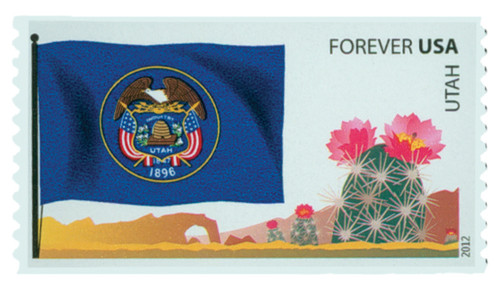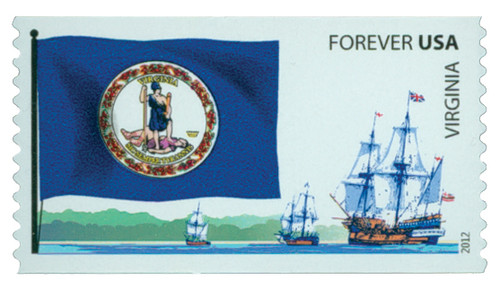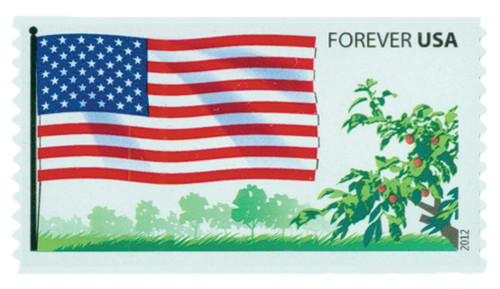
# 4331 - 2012 First-Class Forever Stamp - Flags of Our Nation: Wyoming
U.S. #4331
2012 45¢ Wyoming
Flags of Our Nation
Issue Date: August 16, 2012
City: Sacramento, CA
Quantity: 25,000,000
Printed By: American Packaging Corp for Sennett Security Products
Printing Method: Photogravure
Color: Multicolored
Flags of Our Nation, Set VI: 2012 marks the sixth and final set of stamps in the series. The state and territory flags reflect the history of each region they represent. The uniqueness of each state flag in the series reflects the diversity of the United States and its territories.
In 1916, the Wyoming chapter of the Daughters of the American Revolution decided it was time for their state to have an official flag. They held a contest to select a design.
Verna Keays had just graduated from the Art Institute of Chicago, and her father encouraged her to submit an entry in the contest. One morning she awoke with an image in her mind, which she sketched out and immediately sent in. Her winning design earned her a $20 prize.
Keays’ image features a bison, the state mammal of Wyoming and a symbol of the plains. The Great Seal is branded on the shoulder of the buffalo.
The blue field of the flag is a reminder of the mountains and sky. The red border represents the Indians who lived on the land. The white exemplifies purity.
The central figure in the state’s seal is a woman standing before a banner proclaiming the state’s motto, “Equal Rights.” Before Wyoming became a state, the territorial government allowed women to vote beginning in 1869. It was the first government in the world to acknowledge this right. Because of this distinction, Wyoming has been nicknamed “The Equality State.”
America’s First Female Governor Elected
On November 4, 1924, Wyoming elected Nellie Tayloe Ross America’s first female governor, again proving its nickname, “The Equality State.”
Wyoming has a proud tradition of leading the nation in women’s rights issues. Wyoming women were the first American women to vote, hold public office, and serve on juries. Women were granted these rights when Wyoming became a territory in 1869. In 1870, Esther H. Morris became our nation’s first woman justice of the peace in Wyoming. When Wyoming became a state in 1890, it became the first women’s suffrage state.
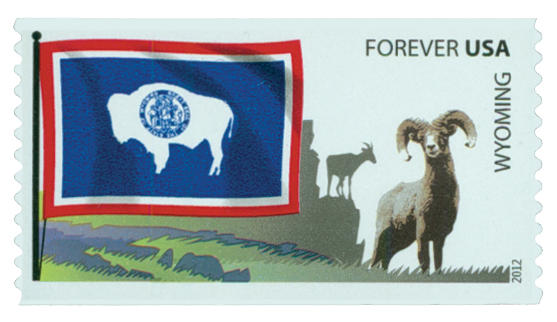
Nellie Tayloe Ross never intended to be a politician, though she was an ambitious woman. Growing up in Missouri and Kansas, her family had suffered major losses during the Civil War and struggled for many years. By the time she married lawyer William Ross in 1902, Nellie hoped to have a more stable life. But William accrued a lot of debt and wanted to enter politics. Though Nellie tried to talk him out of a political career, she supported him when he was elected governor of Wyoming in 1922. William frequently consulted Nellie on political issues and she was excited to discuss them with him.

William’s health took a drastic turn in the fall of 1924, and he died on October 2. As the First Lady of Wyoming, Nellie held her composure at the public funeral. Upon returning to the governor’s mansion to be with her family, Nellie was met by the chairman of the state Democratic Committee. He asked if she would consider running for governor in her husband’s place in the election that was just a month away.
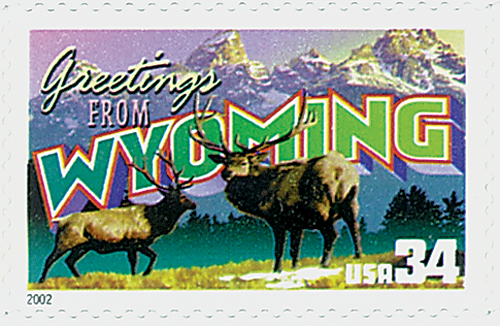
Nellie was conflicted. Her family and friends told her it was a bad idea, that it was a man’s job, and that a potential loss would be devastating. However, Nellie was still mourning her husband’s death and also needed the money to support herself and her children. Ultimately, she decided on October 14th to run, just 45 minutes before the deadline. Nellie didn’t campaign for herself, though her supporters did extensively.
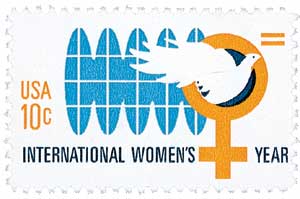
On November 4, 1924, Nellie won the election by 8,000 votes – even more than her husband’s victory two years earlier. After her inauguration the following January, Nellie stated that she would continue three of her husband’s policies: spending cuts, state loans for farmers and ranchers, and prohibition. She also introduced eight proposals of her own: city, county, and school district budgets, state bank regulations, mineral royalties for schools, improved safety for coal miners, and cutting back on child labor, among other issues. However, she was a lone Democrat surrounded by Republicans who opposed many of her ideas. But they did support five of her proposals.
Nellie became a national figure as the first female governor and spent much of the next two years delivering speeches. She narrowly lost the election of 1926, but went on to serve as the first female director of the U.S. Mint.
U.S. #4331
2012 45¢ Wyoming
Flags of Our Nation
Issue Date: August 16, 2012
City: Sacramento, CA
Quantity: 25,000,000
Printed By: American Packaging Corp for Sennett Security Products
Printing Method: Photogravure
Color: Multicolored
Flags of Our Nation, Set VI: 2012 marks the sixth and final set of stamps in the series. The state and territory flags reflect the history of each region they represent. The uniqueness of each state flag in the series reflects the diversity of the United States and its territories.
In 1916, the Wyoming chapter of the Daughters of the American Revolution decided it was time for their state to have an official flag. They held a contest to select a design.
Verna Keays had just graduated from the Art Institute of Chicago, and her father encouraged her to submit an entry in the contest. One morning she awoke with an image in her mind, which she sketched out and immediately sent in. Her winning design earned her a $20 prize.
Keays’ image features a bison, the state mammal of Wyoming and a symbol of the plains. The Great Seal is branded on the shoulder of the buffalo.
The blue field of the flag is a reminder of the mountains and sky. The red border represents the Indians who lived on the land. The white exemplifies purity.
The central figure in the state’s seal is a woman standing before a banner proclaiming the state’s motto, “Equal Rights.” Before Wyoming became a state, the territorial government allowed women to vote beginning in 1869. It was the first government in the world to acknowledge this right. Because of this distinction, Wyoming has been nicknamed “The Equality State.”
America’s First Female Governor Elected
On November 4, 1924, Wyoming elected Nellie Tayloe Ross America’s first female governor, again proving its nickname, “The Equality State.”
Wyoming has a proud tradition of leading the nation in women’s rights issues. Wyoming women were the first American women to vote, hold public office, and serve on juries. Women were granted these rights when Wyoming became a territory in 1869. In 1870, Esther H. Morris became our nation’s first woman justice of the peace in Wyoming. When Wyoming became a state in 1890, it became the first women’s suffrage state.

Nellie Tayloe Ross never intended to be a politician, though she was an ambitious woman. Growing up in Missouri and Kansas, her family had suffered major losses during the Civil War and struggled for many years. By the time she married lawyer William Ross in 1902, Nellie hoped to have a more stable life. But William accrued a lot of debt and wanted to enter politics. Though Nellie tried to talk him out of a political career, she supported him when he was elected governor of Wyoming in 1922. William frequently consulted Nellie on political issues and she was excited to discuss them with him.

William’s health took a drastic turn in the fall of 1924, and he died on October 2. As the First Lady of Wyoming, Nellie held her composure at the public funeral. Upon returning to the governor’s mansion to be with her family, Nellie was met by the chairman of the state Democratic Committee. He asked if she would consider running for governor in her husband’s place in the election that was just a month away.

Nellie was conflicted. Her family and friends told her it was a bad idea, that it was a man’s job, and that a potential loss would be devastating. However, Nellie was still mourning her husband’s death and also needed the money to support herself and her children. Ultimately, she decided on October 14th to run, just 45 minutes before the deadline. Nellie didn’t campaign for herself, though her supporters did extensively.

On November 4, 1924, Nellie won the election by 8,000 votes – even more than her husband’s victory two years earlier. After her inauguration the following January, Nellie stated that she would continue three of her husband’s policies: spending cuts, state loans for farmers and ranchers, and prohibition. She also introduced eight proposals of her own: city, county, and school district budgets, state bank regulations, mineral royalties for schools, improved safety for coal miners, and cutting back on child labor, among other issues. However, she was a lone Democrat surrounded by Republicans who opposed many of her ideas. But they did support five of her proposals.
Nellie became a national figure as the first female governor and spent much of the next two years delivering speeches. She narrowly lost the election of 1926, but went on to serve as the first female director of the U.S. Mint.








